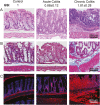Mechanoscopy: A Novel Device and Procedure for in vivo Detection of Chronic Colitis in Mice
- PMID: 35325126
- PMCID: PMC9340527
- DOI: 10.1093/ibd/izac046
Mechanoscopy: A Novel Device and Procedure for in vivo Detection of Chronic Colitis in Mice
Abstract
Background: Gut stiffening caused by fibrosis plays a critical role in the progression of inflammatory bowel disease (IBD) and colon cancer. Previous studies have characterized the biomechanical response of healthy and pathological gut, with most measurements obtained ex vivo.
Methods: Here, we developed a device and accompanying procedure for in vivo quantification of gut stiffness, termed mechanoscopy. Mechanoscopy includes a flexible balloon catheter, pressure sensor, syringe pump, and control system. The control system activates the balloon catheter and performs automated measurements of the gut stress-strain biomechanical response.
Results: A gut stiffness index (GSI) is identified based on the slope of the obtained stress-strain response. Using a colitis mouse model, we demonstrated that GSI positively correlates with the extent of gut fibrosis, the severity of mucosal damage, and the infiltration of immune cells. Furthermore, a critical strain value is suggested, and GSI efficiently detects pathological gut fibrotic stiffening when the strain exceeds this value.
Conclusions: Based on these results, we envision that mechanoscopy and GSI will facilitate the clinical diagnosis of IBD.
Keywords: gut fibrosis; gut inflammation; tissue stiffness.
Plain language summary
Here, we present a novel procedure/device, termed mechanoscopy, which we have demonstrated to accurately detect and differentiate between fibrosis and inflammation in rodent models of colitis. Thus, mechanoscopy offers a translationally relevant approach for ultrasensitive and minimally invasive IBD diagnosis.
© The Author(s) 2022. Published by Oxford University Press on behalf of Crohn’s & Colitis Foundation. All rights reserved. For permissions, please e-mail: journals.permissions@oup.com.
Figures





References
-
- Zhao J, Liao D, Wilkens R, Krogh K, Glerup H, Gregersen H. Bowel stiffness associated with histopathologic scoring of stenosis in patients with Crohn’s disease. Acta Biomater. 2021;130:332–342. - PubMed
-
- Venu VKP, Alston L, Iftinca M, et al.Nr4A1 modulates inflammation-associated intestinal fibrosis and dampens fibrogenic signaling in myofibroblasts. 2021;321(3):G297–G297. - PubMed
-
- Gabbiadini R, Zacharopoulou E, Furfaro F, et al.Application of ultrasound elastography for assessing intestinal fibrosis in inflammatory bowel disease: fiction or reality? Curr Drug Targets. 2021;22(3):347–355. - PubMed

